The Gospel of St. Matthew
Year A
Introduction In our three year cycle of Gospels, Year
A is designated the year of the Gospel of St Mathew. Written around
80-90 AD most likely for the Christian community of Antioch of Syria or
the community in Palestine. Addressed to a primarily Greek speaking Jewish
community, it was deeply influenced by Judaism and seeks to portray Jesus
as long awaited the Messiah of the OT who had achieved more than Judaism
could ever have imagined. In the aftermath of the fall of the Temple in
70AD Matthew believed that the Church or Christian community had replaced
Israel as the locus of divine activity in the world and become the means
by which the Kingdom of God is to be completed in the world. In some ways
it can be said to be in the form of a catechism or handbook for daily living
of the Christian vocation.
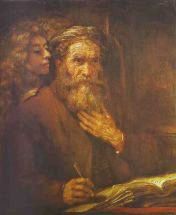 Who is
Matthew The name Matthew is derived from the Hebrew "Mattija"
meaning
"gift of Yahweh" a name usually translated into Greek as "Matthaios".
The person we now know as the Evangelist is spoken of five times in the
NT. First when he is called by Jesus (Mt 9:9) and then four times
when he is listed among the apostles (Lk 6:15, Mk 3:18, Mt 10:3 and
Acts 1:13).
Who is
Matthew The name Matthew is derived from the Hebrew "Mattija"
meaning
"gift of Yahweh" a name usually translated into Greek as "Matthaios".
The person we now know as the Evangelist is spoken of five times in the
NT. First when he is called by Jesus (Mt 9:9) and then four times
when he is listed among the apostles (Lk 6:15, Mk 3:18, Mt 10:3 and
Acts 1:13).
As Jesus passed
on from there, he saw a man named Matthew sitting at the customs post.
He said to him, "Follow me." And he got up and followed him. While he was
at table in his house, many tax collectors and sinners came and sat with
Jesus and his disciples. The Pharisees saw this and said to his disciples,
"Why does your teacher eat with tax collectors and sinners?" (Mt
9:9-11)
As in all three synoptic gospels the common detail about this would
be disciple is his profession as "tax collector". However,
we should note at this stage that while the first gospel names him as Matthew
both Mark and Luke use the name Levi (Mk 2:13-17 and Lk 5:27-32).
It is probable that the name Mattija was a name conferred on him by Jesus
when he called him into the inner circle of the Apostolate and reflected
his conversion and new way of life. Mark tells us that Matthew was the
"son
of Alphaeus" (Mk 2:14) a detail that has led many such as
John Chrysostom to suggest that he and James the lesser were brothers.
The historian Eusebius suggests that he was Syrian by birth and later came
to live in Galilee, most likely Capernaum, when appointed as a tax-collector
by Herod Antipas, the Roman appointed King of the Jews.
A Jew by race and faith, Matthew chose a career in the service of Herod
which earned him the hatred of the local community especially that of the
Pharisees. Clearly Matthew was better educated than many of the other apostles,
with a good head for figures, rates and the value of materials. He was
shrewd and of calm disposition perhaps with an appetite for the good life
and all that his position in Roman provincial society could offer. Matthew
must have been well aware of the distain with which he was held in society
but was unmoved by this consideration.
Aside from listing Matthew among the Apostles, no further explicit reference
is made to him in scripture. Presumably, Matthew was among the apostles
and disciples who traveled with Jesus during his mission up to the time
of
his Passion. During that time he, with the other disciples, were taught
by Jesus, witnessed his miracles and followed him through the Galilean
countryside as he preached the Kingdom of God. Presumably, Matthew also
forsakes Jesus in the moment of his trial but was later re-confirmed in
his faith in the many post-Resurrection appearances. The last reference
to Matthew in scripture describes how he withdrew with the other disciples
to the upper room after the Ascension and joined in prayer with Mary, the
mother of Jesus and his brethren (Acts 1:10-14). However, we can
also presume that he was present for the great commission "to go
and make disciples of all nations" (Mt 28:19), an event
that would loom greatly in the formulation of his gospel.
Of his subsequent life little is know for certain. Tradition tells us
that Matthew may have preached the gospel among the Jewish people before
traveling to such areas as the Caspian Sea, Persia, Macedonia and Syria.
Doubts also exist as to whether Matthew suffered a martyr’s death. Heraleon
the historian, later quoted by Clement of Alexandria, suggests that he
died of natural causes. However, the Church has always venerated Matthew
as a martyr, although it is silent on the type of death he suffered. The
Latin Church celebrates the feast of Matthew the Evangelist on September
21 while the Greek Church celebrates it on November 16. Traditionally,
the Evangelist is represented by a "winged man carrying a lance in
his hand", the supposed instrument of his death.
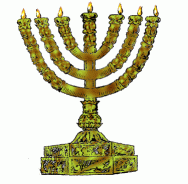 Matthew:
the Evangelist of the Second Gospel? Over the last century biblical
scholars have debated the question of whether this Gospel was actually
written by the apostle Matthew or merely attributed to him by another disciple
who was not an eyewitness to the events and teachings of the life of Jesus
Christ. It is clear that most of the material contained in the sixteen
chapters of Mark’s gospel have found their way into this Gospel. However,
the writer did not simply copy the older document but instead freely edited
and redacted the earlier document joining it with material from a collection
of Jesus’ sayings (often referred to as Q from the German "Quelle"
meaning source) and material peculiar to Matthew or his disciple. Nowhere
in the text does the Evangelist claim to have been an eyewitness to or
indeed personally involved in the events he describes, a factthat would
seem strange for one personally involved in the events of the life of Jesus.
Indeed, the opening title "according to Matthew" was not
part of the original text but a later addition, perhaps reflecting Matthew’s
patronal status within the community for which it was first written. From
what we know about Matthew, we must ask the question of how someone on
the margins of Jewish society and religious life could possibly have such
an extensive education with which to produce this very Jewish document?
Matthew:
the Evangelist of the Second Gospel? Over the last century biblical
scholars have debated the question of whether this Gospel was actually
written by the apostle Matthew or merely attributed to him by another disciple
who was not an eyewitness to the events and teachings of the life of Jesus
Christ. It is clear that most of the material contained in the sixteen
chapters of Mark’s gospel have found their way into this Gospel. However,
the writer did not simply copy the older document but instead freely edited
and redacted the earlier document joining it with material from a collection
of Jesus’ sayings (often referred to as Q from the German "Quelle"
meaning source) and material peculiar to Matthew or his disciple. Nowhere
in the text does the Evangelist claim to have been an eyewitness to or
indeed personally involved in the events he describes, a factthat would
seem strange for one personally involved in the events of the life of Jesus.
Indeed, the opening title "according to Matthew" was not
part of the original text but a later addition, perhaps reflecting Matthew’s
patronal status within the community for which it was first written. From
what we know about Matthew, we must ask the question of how someone on
the margins of Jewish society and religious life could possibly have such
an extensive education with which to produce this very Jewish document?
However, saying that Matthew might now have been the actual writer of
this Gospel is not to say that we know nothing about its writer. Whoever
wrote this gospel had a firm knowledge of Hebrew scripture and the Jewish
way of life. From the very beginning the evangelist shows a deep interest
in identifying OT quotations which refer directly to Jesus of Nazareth
and which, in his view, were subsequently fulfilled (Mt 1:22-23, 2:15-18)
while much of the Sermon on the Mount in chapter 5 has a distinct Jewish
and Talmudic feel to it and echoes much of Jewish ethical teaching of the
day. Thus Matthew’s Gospel is often referred to as the most "Jewish"
of all four gospels and clearly reflects many of the issues alive within
the community it was written for, such as the relationship of Jesus with
the Law, the role of the synagogue and the authority of the religious leadership.
If as most biblical scholars now think this gospel was written for a
primarily Jewish Christian community, this may explain why Matthew omits
many of the explanations of Jewish customs such as ritual purity (Mk
7:3-4) and instead pays more attention to the growing opposition of
the Jewish leadership to the ministry of Jesus (Mt 23). In the same
vein, Matthew places the teachings of Jesus on marriage within their Jewish
context on divorce (Mt 5:32 and 19:9) and expands his version of
the Lord’s Prayer (Mt 6:9-13) with phrases typical of Jewish prayer.
 One obvious
reason for the Evangelist’s decision to revise the gospel of Mark was his
desire to add and supplement it with additional material. However, if as
most now believe, the writer of this gospel was not an eyewitness to the
events where did he get this additional information from? As we noted earlier,
one possible source was the Q document: a collection of sayings
of Jesus already written down in Greek by the year 50AD. In literary form
it was very similar to the OT Book of Proverbs with no passion narrative.
Another was his own desire to use what was before him to answer the particular
needs of the community for which he was writing. Yet however, this is all
hypothetical, for no copy of the Q document survives and it can
only be constructed by careful analysis of the synoptic gospels. But it
is one of the better explanations as to the source of the Evangelist’s
material for some of the more important speeches of Jesus such as the Sermon
on the Mount and the Missionary Discourses. Biblical scholars usually use
the letter M to identify material that is particular to Matthew
and speaks to issues within his community. This is particularly true when
the Evangelist addresses the issue of the identity of Jesus as the long
awaited Messiah of Israel in the Infancy Narrative (Mt 1-2) and
the post-resurrection appearance in chapter 28. Some have proposed the
view that this material may constitute an original gospel type document
written in Hebrew/Aramaic by Matthew and later translated by one of his
disciples into Greek, thus giving us the patronal connection with Matthew
and explaining why there are few if any personal remembrances.
One obvious
reason for the Evangelist’s decision to revise the gospel of Mark was his
desire to add and supplement it with additional material. However, if as
most now believe, the writer of this gospel was not an eyewitness to the
events where did he get this additional information from? As we noted earlier,
one possible source was the Q document: a collection of sayings
of Jesus already written down in Greek by the year 50AD. In literary form
it was very similar to the OT Book of Proverbs with no passion narrative.
Another was his own desire to use what was before him to answer the particular
needs of the community for which he was writing. Yet however, this is all
hypothetical, for no copy of the Q document survives and it can
only be constructed by careful analysis of the synoptic gospels. But it
is one of the better explanations as to the source of the Evangelist’s
material for some of the more important speeches of Jesus such as the Sermon
on the Mount and the Missionary Discourses. Biblical scholars usually use
the letter M to identify material that is particular to Matthew
and speaks to issues within his community. This is particularly true when
the Evangelist addresses the issue of the identity of Jesus as the long
awaited Messiah of Israel in the Infancy Narrative (Mt 1-2) and
the post-resurrection appearance in chapter 28. Some have proposed the
view that this material may constitute an original gospel type document
written in Hebrew/Aramaic by Matthew and later translated by one of his
disciples into Greek, thus giving us the patronal connection with Matthew
and explaining why there are few if any personal remembrances.
The Theology of Matthew To begin a full explanation of
the gospel’s theology one needs to understand the impact that the Fall
of Jerusalem and the Temple had on Judaism and how it gave rise to many
differing responses; Apocalyptic, Rabbinic
and Matthean. Having already experienced national turmoil with the Babylonian
exile, many attempted to place the events in the context of God’s judgment
on the people that would herald in a new age. This new age was dawning
on the face of the earth and would be signaled by ‘signs’
during which the messiah would be revealed. As the people patiently awaited
the arrival of this new era and Israel’s vindication, Jews were expected
to abide by the Law; the guide given to Israel by Yahweh. This would offer
them sure guidance as they waited and remind them that the way to this
new world was both narrow and reserved to the few who remained faithful,
themes which would be echoed in the gospel:
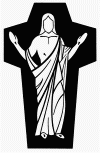 As a faithful
Jew and a witness to the events of 70AD the Evangelist was clearly concerned
for the survival and future development of Judaism and the Chosen People,
albeit in light of the new reality that Jesus of Nazareth was the long
awaited Messiah. Thus, like the other responses Matthew demonstrates a
rejection of alternative pathways of preservation that could never be described
as politically correct or even moderate. For him the future of Judaism
lay not with adherence to the Law alone but with the person and teachings
of Jesus. He was the new direction for Judaism and the fulfillment of all
that was promised in scripture. The most obvious element of this is to
be found in the use of the words "all this too place to fulfill what
the Lord has spoken through the prophets" a formula that is dotted
throughout the gospel. In the Infancy Narrative the extraordinary nature
of the conception and birth of Jesus is described as fulfilling the words
of Isaiah. For the Evangelist the whole life of Jesus of Nazareth bears
witness to the predictions made in the OT or perhaps these OT predictions
are in keeping with the life of Jesus! Matthew sought to demonstrate to
his audience, whether coverts or still unbelieving Jews that in Jesus the
ancient prophecies had been realized in their entirety.
As a faithful
Jew and a witness to the events of 70AD the Evangelist was clearly concerned
for the survival and future development of Judaism and the Chosen People,
albeit in light of the new reality that Jesus of Nazareth was the long
awaited Messiah. Thus, like the other responses Matthew demonstrates a
rejection of alternative pathways of preservation that could never be described
as politically correct or even moderate. For him the future of Judaism
lay not with adherence to the Law alone but with the person and teachings
of Jesus. He was the new direction for Judaism and the fulfillment of all
that was promised in scripture. The most obvious element of this is to
be found in the use of the words "all this too place to fulfill what
the Lord has spoken through the prophets" a formula that is dotted
throughout the gospel. In the Infancy Narrative the extraordinary nature
of the conception and birth of Jesus is described as fulfilling the words
of Isaiah. For the Evangelist the whole life of Jesus of Nazareth bears
witness to the predictions made in the OT or perhaps these OT predictions
are in keeping with the life of Jesus! Matthew sought to demonstrate to
his audience, whether coverts or still unbelieving Jews that in Jesus the
ancient prophecies had been realized in their entirety.
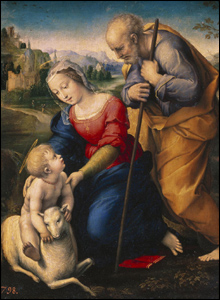 The Infancy
Narrative: Perhaps no other part of Matthew’s Gospel is as well
known to us as the Infancy Narrative (Chpts 1and 2). Together with the
narrative from Luke’s Gospel it forms the core of our Christmas story.
It is from Matthew we get the details of the Magi, the Slaughter of the
Holy Innocents and the Flight into Egypt so essential to story. However,
this gospel account is decidedly different from that of Luke. Where Mary
is the central figure in Luke, it is Joseph who is the primary character
in this gospel. As the earthly father figure in the life of Jesus, it is
Joseph who gives him his legitimacy in the eyes of Jewish culture and ensures
the Jesus is "of the royal house of David" and thereby the
long awaited fulfillment of the David promise. As a model of biblical piety
he trusts in divine communications and acts upon them, thus allowing the
child, entrusted into his care, to reach maturity. From this perspective,
Joseph emerges as a major figure of the Matthean Advent season.
The Infancy
Narrative: Perhaps no other part of Matthew’s Gospel is as well
known to us as the Infancy Narrative (Chpts 1and 2). Together with the
narrative from Luke’s Gospel it forms the core of our Christmas story.
It is from Matthew we get the details of the Magi, the Slaughter of the
Holy Innocents and the Flight into Egypt so essential to story. However,
this gospel account is decidedly different from that of Luke. Where Mary
is the central figure in Luke, it is Joseph who is the primary character
in this gospel. As the earthly father figure in the life of Jesus, it is
Joseph who gives him his legitimacy in the eyes of Jewish culture and ensures
the Jesus is "of the royal house of David" and thereby the
long awaited fulfillment of the David promise. As a model of biblical piety
he trusts in divine communications and acts upon them, thus allowing the
child, entrusted into his care, to reach maturity. From this perspective,
Joseph emerges as a major figure of the Matthean Advent season.
The gospel begins with a genealogy of the House of David to which Joseph
belonged. This serves to place Jesus into the royal house of Israel and
to situate his birth within the overall history of Israel. The genealogy
takes Abraham, David and the Babylonian Exile as it key markers and serves
to connect the birth of Jesus with fundamental events in the life of the
Chosen People. It should be remembered that scriptural genealogies, especially
oral ones, lack the rigidity and structure that modern genealogies have.
If taken side by side with the genealogy in Luke (Lk 3:23-38) one
can see some important differences: where Luke goes backwards in his genealogy,
Matthew comes forward. Luke traces Jesus’ Davidic descent from Nathan rather
than Solomon and gives the father of Joseph as Eli rather than Jacob. While
Luke is keen to stress universal salvation, Matthew stresses the fulfillment
of the Davidic promise for the Chosen People.
One other major difference is Matthew’s inclusion of five women in the
genealogy, a break with tradition and most unusual in a patriarchal society.
In their own way each female inclusion is a departure from the ordinary
and shows how God uses such events to fulfill his will and to foreshadow
the unique birth of Jesus:
Whereas the genealogy established Jesus as the "Son of David"
through his legal father Joseph, the story of his birth explains how his
conception and birth came about through the power of the Holy Spirit. Joseph’s
choice is an agonizing one but the agony is cut short by divine communication
through a dream in which he is given instructions by an angel (Gen 16:7-13,
Ex 3:2, Num 22:22 Jdg 6:11-24, Zech 1:1, 3:1). Here the angel makes
known the will of God for the future. At the center of the dream is the
angelic declaration of unborn Jesus’ conception, name and identity, each
one as we already saw a fulfillment of the OT!
In contrast to Luke’s account of the nativity, Matthew has only a brief
and passing reference to the birth in Bethlehem, the ancestral city of
David. While the major concern of chapter one is the "who"
of Jesus, the concern of chapter two is the "where". This
chapter is best divided into four parts:
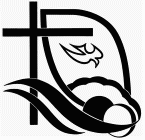
-
The coming of the Magi (Mt 2:1-12)
(Bethlehem)
-
The flight into Egypt (Mt 2:13-15) (Egypt)
-
The slaughter of the Innocents (Mt 2:16) (Bethlehem)
-
The return from Egypt (Mt 2:19-23) (Egypt)
While the Magi symbolize Gentile believers coming to pay homage to the
"the
King of the Jews" and as kings stand in direct contrast with Herod,
the once who claims to be "King of the Jews"(Mt 2:8), it
is the Moses-Jesus typology that dominates the chapter.
-
Pharaoh is king of Egypt: Herod
claims to be king of the Jews
-
Decree of death from the wicked
(pharaoh) king.
-
Moses flees from Egypt: the Holy
Family flees to Egypt
-
The Moses story is about man and
boy: Jesus is a child.
-
Slaughter of the innocent children
in Egypt and Bethlehem
-
Return after the death of the wicked
king.
Once again this typology serves to root Jesus in the history of the Chosen
People, indeed his divine and royal son-ship is specifically tied to Israel’s
experience as God’s chosen "out of Egypt I called my son" (Mt
2:15), an experience that now lay open to new Israel: the Church.
Go back to the Gospel for the forthcoming
weekend and join us in breaking open the Word.
 Who is
Matthew The name Matthew is derived from the Hebrew "Mattija"
meaning
"gift of Yahweh" a name usually translated into Greek as "Matthaios".
The person we now know as the Evangelist is spoken of five times in the
NT. First when he is called by Jesus (Mt 9:9) and then four times
when he is listed among the apostles (Lk 6:15, Mk 3:18, Mt 10:3 and
Acts 1:13).
Who is
Matthew The name Matthew is derived from the Hebrew "Mattija"
meaning
"gift of Yahweh" a name usually translated into Greek as "Matthaios".
The person we now know as the Evangelist is spoken of five times in the
NT. First when he is called by Jesus (Mt 9:9) and then four times
when he is listed among the apostles (Lk 6:15, Mk 3:18, Mt 10:3 and
Acts 1:13).
 Matthew:
the Evangelist of the Second Gospel? Over the last century biblical
scholars have debated the question of whether this Gospel was actually
written by the apostle Matthew or merely attributed to him by another disciple
who was not an eyewitness to the events and teachings of the life of Jesus
Christ. It is clear that most of the material contained in the sixteen
chapters of Mark’s gospel have found their way into this Gospel. However,
the writer did not simply copy the older document but instead freely edited
and redacted the earlier document joining it with material from a collection
of Jesus’ sayings (often referred to as Q from the German "Quelle"
meaning source) and material peculiar to Matthew or his disciple. Nowhere
in the text does the Evangelist claim to have been an eyewitness to or
indeed personally involved in the events he describes, a factthat would
seem strange for one personally involved in the events of the life of Jesus.
Indeed, the opening title "according to Matthew" was not
part of the original text but a later addition, perhaps reflecting Matthew’s
patronal status within the community for which it was first written. From
what we know about Matthew, we must ask the question of how someone on
the margins of Jewish society and religious life could possibly have such
an extensive education with which to produce this very Jewish document?
Matthew:
the Evangelist of the Second Gospel? Over the last century biblical
scholars have debated the question of whether this Gospel was actually
written by the apostle Matthew or merely attributed to him by another disciple
who was not an eyewitness to the events and teachings of the life of Jesus
Christ. It is clear that most of the material contained in the sixteen
chapters of Mark’s gospel have found their way into this Gospel. However,
the writer did not simply copy the older document but instead freely edited
and redacted the earlier document joining it with material from a collection
of Jesus’ sayings (often referred to as Q from the German "Quelle"
meaning source) and material peculiar to Matthew or his disciple. Nowhere
in the text does the Evangelist claim to have been an eyewitness to or
indeed personally involved in the events he describes, a factthat would
seem strange for one personally involved in the events of the life of Jesus.
Indeed, the opening title "according to Matthew" was not
part of the original text but a later addition, perhaps reflecting Matthew’s
patronal status within the community for which it was first written. From
what we know about Matthew, we must ask the question of how someone on
the margins of Jewish society and religious life could possibly have such
an extensive education with which to produce this very Jewish document?
 One obvious
reason for the Evangelist’s decision to revise the gospel of Mark was his
desire to add and supplement it with additional material. However, if as
most now believe, the writer of this gospel was not an eyewitness to the
events where did he get this additional information from? As we noted earlier,
one possible source was the Q document: a collection of sayings
of Jesus already written down in Greek by the year 50AD. In literary form
it was very similar to the OT Book of Proverbs with no passion narrative.
Another was his own desire to use what was before him to answer the particular
needs of the community for which he was writing. Yet however, this is all
hypothetical, for no copy of the Q document survives and it can
only be constructed by careful analysis of the synoptic gospels. But it
is one of the better explanations as to the source of the Evangelist’s
material for some of the more important speeches of Jesus such as the Sermon
on the Mount and the Missionary Discourses. Biblical scholars usually use
the letter M to identify material that is particular to Matthew
and speaks to issues within his community. This is particularly true when
the Evangelist addresses the issue of the identity of Jesus as the long
awaited Messiah of Israel in the Infancy Narrative (Mt 1-2) and
the post-resurrection appearance in chapter 28. Some have proposed the
view that this material may constitute an original gospel type document
written in Hebrew/Aramaic by Matthew and later translated by one of his
disciples into Greek, thus giving us the patronal connection with Matthew
and explaining why there are few if any personal remembrances.
One obvious
reason for the Evangelist’s decision to revise the gospel of Mark was his
desire to add and supplement it with additional material. However, if as
most now believe, the writer of this gospel was not an eyewitness to the
events where did he get this additional information from? As we noted earlier,
one possible source was the Q document: a collection of sayings
of Jesus already written down in Greek by the year 50AD. In literary form
it was very similar to the OT Book of Proverbs with no passion narrative.
Another was his own desire to use what was before him to answer the particular
needs of the community for which he was writing. Yet however, this is all
hypothetical, for no copy of the Q document survives and it can
only be constructed by careful analysis of the synoptic gospels. But it
is one of the better explanations as to the source of the Evangelist’s
material for some of the more important speeches of Jesus such as the Sermon
on the Mount and the Missionary Discourses. Biblical scholars usually use
the letter M to identify material that is particular to Matthew
and speaks to issues within his community. This is particularly true when
the Evangelist addresses the issue of the identity of Jesus as the long
awaited Messiah of Israel in the Infancy Narrative (Mt 1-2) and
the post-resurrection appearance in chapter 28. Some have proposed the
view that this material may constitute an original gospel type document
written in Hebrew/Aramaic by Matthew and later translated by one of his
disciples into Greek, thus giving us the patronal connection with Matthew
and explaining why there are few if any personal remembrances.
 As a faithful
Jew and a witness to the events of 70AD the Evangelist was clearly concerned
for the survival and future development of Judaism and the Chosen People,
albeit in light of the new reality that Jesus of Nazareth was the long
awaited Messiah. Thus, like the other responses Matthew demonstrates a
rejection of alternative pathways of preservation that could never be described
as politically correct or even moderate. For him the future of Judaism
lay not with adherence to the Law alone but with the person and teachings
of Jesus. He was the new direction for Judaism and the fulfillment of all
that was promised in scripture. The most obvious element of this is to
be found in the use of the words "all this too place to fulfill what
the Lord has spoken through the prophets" a formula that is dotted
throughout the gospel. In the Infancy Narrative the extraordinary nature
of the conception and birth of Jesus is described as fulfilling the words
of Isaiah. For the Evangelist the whole life of Jesus of Nazareth bears
witness to the predictions made in the OT or perhaps these OT predictions
are in keeping with the life of Jesus! Matthew sought to demonstrate to
his audience, whether coverts or still unbelieving Jews that in Jesus the
ancient prophecies had been realized in their entirety.
As a faithful
Jew and a witness to the events of 70AD the Evangelist was clearly concerned
for the survival and future development of Judaism and the Chosen People,
albeit in light of the new reality that Jesus of Nazareth was the long
awaited Messiah. Thus, like the other responses Matthew demonstrates a
rejection of alternative pathways of preservation that could never be described
as politically correct or even moderate. For him the future of Judaism
lay not with adherence to the Law alone but with the person and teachings
of Jesus. He was the new direction for Judaism and the fulfillment of all
that was promised in scripture. The most obvious element of this is to
be found in the use of the words "all this too place to fulfill what
the Lord has spoken through the prophets" a formula that is dotted
throughout the gospel. In the Infancy Narrative the extraordinary nature
of the conception and birth of Jesus is described as fulfilling the words
of Isaiah. For the Evangelist the whole life of Jesus of Nazareth bears
witness to the predictions made in the OT or perhaps these OT predictions
are in keeping with the life of Jesus! Matthew sought to demonstrate to
his audience, whether coverts or still unbelieving Jews that in Jesus the
ancient prophecies had been realized in their entirety.
 The Infancy
Narrative: Perhaps no other part of Matthew’s Gospel is as well
known to us as the Infancy Narrative (Chpts 1and 2). Together with the
narrative from Luke’s Gospel it forms the core of our Christmas story.
It is from Matthew we get the details of the Magi, the Slaughter of the
Holy Innocents and the Flight into Egypt so essential to story. However,
this gospel account is decidedly different from that of Luke. Where Mary
is the central figure in Luke, it is Joseph who is the primary character
in this gospel. As the earthly father figure in the life of Jesus, it is
Joseph who gives him his legitimacy in the eyes of Jewish culture and ensures
the Jesus is "of the royal house of David" and thereby the
long awaited fulfillment of the David promise. As a model of biblical piety
he trusts in divine communications and acts upon them, thus allowing the
child, entrusted into his care, to reach maturity. From this perspective,
Joseph emerges as a major figure of the Matthean Advent season.
The Infancy
Narrative: Perhaps no other part of Matthew’s Gospel is as well
known to us as the Infancy Narrative (Chpts 1and 2). Together with the
narrative from Luke’s Gospel it forms the core of our Christmas story.
It is from Matthew we get the details of the Magi, the Slaughter of the
Holy Innocents and the Flight into Egypt so essential to story. However,
this gospel account is decidedly different from that of Luke. Where Mary
is the central figure in Luke, it is Joseph who is the primary character
in this gospel. As the earthly father figure in the life of Jesus, it is
Joseph who gives him his legitimacy in the eyes of Jewish culture and ensures
the Jesus is "of the royal house of David" and thereby the
long awaited fulfillment of the David promise. As a model of biblical piety
he trusts in divine communications and acts upon them, thus allowing the
child, entrusted into his care, to reach maturity. From this perspective,
Joseph emerges as a major figure of the Matthean Advent season.
